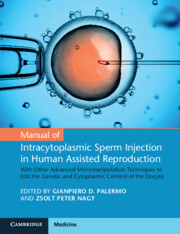 Manual of Intracytoplasmic Sperm Injection in Human Assisted Reproduction
Manual of Intracytoplasmic Sperm Injection in Human Assisted Reproduction The History That Changed the Treatment of Male Factor Infertility
Published online by Cambridge University Press: 02 December 2021
This chapter reviews the short period between the exploration of male factor treatment using standard in vitro fertilization in small clinical series initiated in the early 1980s and subsequent development of micromanipulation technologies before ICSI. Instrumental fertilization was developed to improve the incidence of fertilization as well as apply the technology to patients with extreme male factor. A decade later, the Brussels team introduced ICSI, with fertilization rates that were at least twice as high compared to those of earlier micromanipulation approaches. A short history of male factor infertility and the biased views medical specialists showed in favor of solely treating the female partner is discussed in the context of discovery of gametes and the process of fertilization in the nineteenth century. The condition of infertility in men was basically considered untreatable until the 1970s, but as a clinical concept, it was also largely ignored. The possibility of using IVF for effectively treating less fertile men was considered experimental in 1980. The technical and physiological background as well as ambiguous animal models before clinical ICSI are evaluated particularly in the context of why early micromanipulation methods such as partial zona dissection and sub-zonal sperm insertion ultimately failed.
To save this book to your Kindle, first ensure [email protected] is added to your Approved Personal Document E-mail List under your Personal Document Settings on the Manage Your Content and Devices page of your Amazon account. Then enter the ‘name’ part of your Kindle email address below. Find out more about saving to your Kindle.
Note you can select to save to either the @free.kindle.com or @kindle.com variations. ‘@free.kindle.com’ emails are free but can only be saved to your device when it is connected to wi-fi. ‘@kindle.com’ emails can be delivered even when you are not connected to wi-fi, but note that service fees apply.
Find out more about the Kindle Personal Document Service.
To save content items to your account, please confirm that you agree to abide by our usage policies. If this is the first time you use this feature, you will be asked to authorise Cambridge Core to connect with your account. Find out more about saving content to Dropbox.
To save content items to your account, please confirm that you agree to abide by our usage policies. If this is the first time you use this feature, you will be asked to authorise Cambridge Core to connect with your account. Find out more about saving content to Google Drive.